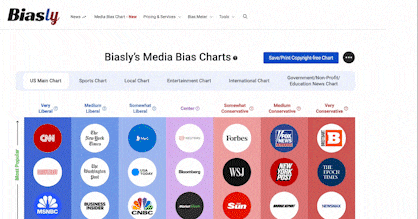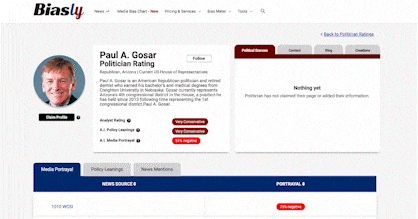 Cleveland.com Article Rating
Cleveland.com Article Rating'Cataclysmic ripple effect:' How Medicaid cuts could harm Ohio's economy
- Bias Rating
50% Medium Conservative
- Reliability
85% ReliableGood
- Policy Leaning
50% Medium Conservative
- Politician Portrayal
-1% Negative
Continue For Free
Create your free account to see the in-depth bias analytics and more.
Continue
Continue
By creating an account, you agree to our Terms and Privacy Policy, and subscribe to email updates. Already a member: Log inBias Score Analysis
The A.I. bias rating includes policy and politician portrayal leanings based on the author’s tone found in the article using machine learning. Bias scores are on a scale of -100% to 100% with higher negative scores being more liberal and higher positive scores being more conservative, and 0% being neutral.
Sentiments
-3% Negative
- Liberal
- Conservative
| Sentence | Sentiment | Bias |
|---|---|---|
Unlock this feature by upgrading to the Pro plan. | ||
Reliability Score Analysis
Policy Leaning Analysis
Politician Portrayal Analysis
Bias Meter
Extremely
Liberal
Very
Liberal
Moderately
Liberal
Somewhat Liberal
Center
Somewhat Conservative
Moderately
Conservative
Very
Conservative
Extremely
Conservative
-100%
Liberal
100%
Conservative

Contributing sentiments towards policy:
61% : "Medicaid is a foundation for health and economic stability," said Teresa Lampl, CEO of the Ohio Council of Behavioral Health & Family Services Providers, which is part of the coalition.53% : At the Clinic, 13% of its patients used Medicaid in 2023.
50% : In another move that could boot Ohioans from the rolls, Ohio has requested a waiver from the federal Centers for Medicare and Medicaid Services to institute a work requirement for Medicaid recipients.
50% : If it accepts Ohio's request, Ohioans would need to be one of the following to qualify for Medicaid: at least 55-years old; employed; enrolled in school or occupational training for at least 20 hours per week; enrolled in an alcohol and drug addiction treatment program; or have intensive physical or mental health needs.
50% : Some hospitals would take the largest hit At three Northeast Ohio hospitals, as many as 21% of patients are on Medicaid.
50% : "Any state or federal changes to Medicaid eligibility and provider payments would create barriers to care for many people in our community and significantly impact our organization financially," said Tracy Carter, system director, government relations and health policy for Summa.
46% : Experts and Democratic lawmakers say that would be nearly impossible without touching Medicaid.
45% : Hospitals - which already pay millions annually to make up the difference between the cost of health care and what Medicaid pays -- would take a financial hit because they would foot the cost of care for the newly uninsured.
44% : If both cuts come to pass, Ohio's entire expansion population will be disenrolled from Medicaid, explained UHCAN Ohio's Rudolph.
44% : While Rudolph said her organization will help newly-uninsured people find healthcare plans through the Affordable Care Act, she's deeply concerned about the potential fallout.
42% : "Reduced reimbursement from the Ohio Medicaid program could lead to reduced access to care, reduction in the services offered, financial instability for healthcare institutions, and further economic instability in Ashtabula County as a whole," said Ashtabula medical center CEO Leonard Stepp, Jr. Medicaid shortfall, percentage of patients shows impact There are two ways to examine the impact on hospitals: Medicaid shortfall and percentage of patient population on Medicaid.
41% : All hospitals would be impacted by the cuts because they must pay for the cost of care that Medicaid doesn't cover.
40% : MetroHealth is "very concerned" about the possible cuts, "because they would negatively impact the most at-risk members of our community who have the greatest need for regular access to health care," a spokesperson said. More than 75% of its patients use government-sponsored insurance like Medicaid, are uninsured or are MetroHealth employees, the health system said.
38% : "Ultimately, wouldn't it be cheaper in the long run to keep people covered and healthy and not have our economic growth and our economic stability implode?" said Charlotte Rudolph, executive director of UHCAN Ohio, an advocacy group supporting affordable health care for Ohioans. Possible changes to Medicaid, explained The roughly 770,000 Ohioans who joined Medicaid under the state's 2013 expansion program are at risk of being kicked off under potential state and federal changes.
33% : CLEVELAND, Ohio - Northeast Ohio hospitals are bracing for a wave of negative impacts if state and federal lawmakers follow through with Medicaid cuts that would take health insurance away from hundreds of thousands of Ohioans.
*Our bias meter rating uses data science including sentiment analysis, machine learning and our proprietary algorithm for determining biases in news articles. Bias scores are on a scale of -100% to 100% with higher negative scores being more liberal and higher positive scores being more conservative, and 0% being neutral. The rating is an independent analysis and is not affiliated nor sponsored by the news source or any other organization.




























